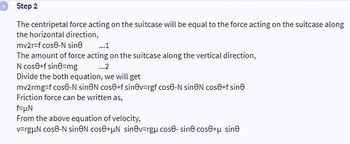The drawing shows a baggage carousel at an airport. Your suitcase has not slid all the way down the slope and is going around at a constant speed on a circle ((r = 12.0 m) as the carousel turns. The coefficient of static friction between the suitcase and the carousel is 0.840, and the angle in the drawing is 12.9°. How much time is required for your suitcase to go around once? Assumme that the static friction between the suitcase and the carousel is at its maximum. Number i Units
The drawing shows a baggage carousel at an airport. Your suitcase has not slid all the way down the slope and is going around at a constant speed on a circle ((r = 12.0 m) as the carousel turns. The coefficient of static friction between the suitcase and the carousel is 0.840, and the angle in the drawing is 12.9°. How much time is required for your suitcase to go around once? Assumme that the static friction between the suitcase and the carousel is at its maximum. Number i Units
Principles of Physics: A Calculus-Based Text
5th Edition
ISBN:9781133104261
Author:Raymond A. Serway, John W. Jewett
Publisher:Raymond A. Serway, John W. Jewett
Chapter5: More Applications Of Newton’s Laws
Section: Chapter Questions
Problem 4P
Related questions
Question
100%

Transcribed Image Text:The drawing shows a baggage carousel at an airport. Your suitcase has not slid all the way down the slope and is going around at a
constant speed on a circle ((r = 12.0 m) as the carousel turns. The coefficient of static friction between the suitcase and the carousel is
0.840, and the angle 0 in the drawing is 12.9°. How much time is required for your suitcase to go around once? Assumme that the static
friction between the suitcase and the carousel is at its maximum.
Number
MO
Units
Expert Solution
This question has been solved!
Explore an expertly crafted, step-by-step solution for a thorough understanding of key concepts.
This is a popular solution!
Trending now
This is a popular solution!
Step by step
Solved in 4 steps

Follow-up Questions
Read through expert solutions to related follow-up questions below.
Follow-up Question
Considering that now I have learned to solve for V & T. My next question is how would I solve for the magnitude & direction of the maximum static frictional force acting on the suitcase? I just began my Physics I course, in your opinion would you consider this word problem to be an intro to physics?
Solution
Follow-up Question
I don't doubt that the answer is correct but I'm having trouble following some of these steps. suppose you could somehow elaborate a little more on step two. a video would be awesome if possible...

Transcribed Image Text:Step 2
The centripetal force acting on the suitcase will be equal to the force acting on the suitcase along
the horizontal direction,
mv2r-f cose-N sine
The amount of force acting on the suitcase along the vertical direction,
N cose+f sine-mg
...2
Divide the both equation, we will get
mv2rmg-f cose-N sineN cos+f sinev=rgf cose-N sineN cos+f sine
Friction force can be written as,
f=μN
From the above equation of velocity,
v=rgμN cose-N sineN cose+μN sinv=rgμ cose-sin cose+μ sin
Solution
Follow-up Question
It seem that in order to solve the above we have to know what is the value of N. What is the value of N??
Solution
Knowledge Booster
Learn more about
Need a deep-dive on the concept behind this application? Look no further. Learn more about this topic, physics and related others by exploring similar questions and additional content below.Recommended textbooks for you

Principles of Physics: A Calculus-Based Text
Physics
ISBN:
9781133104261
Author:
Raymond A. Serway, John W. Jewett
Publisher:
Cengage Learning

Principles of Physics: A Calculus-Based Text
Physics
ISBN:
9781133104261
Author:
Raymond A. Serway, John W. Jewett
Publisher:
Cengage Learning